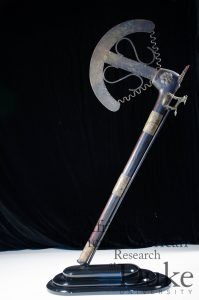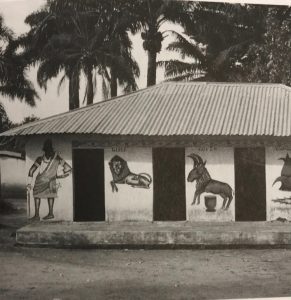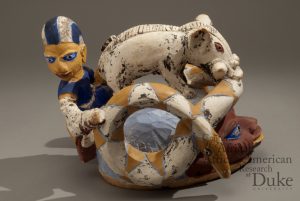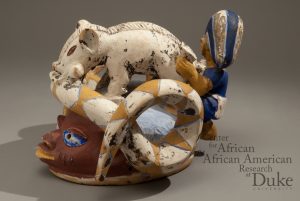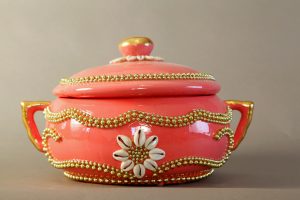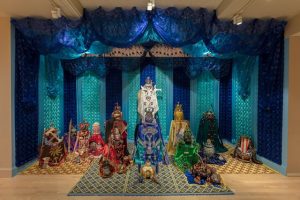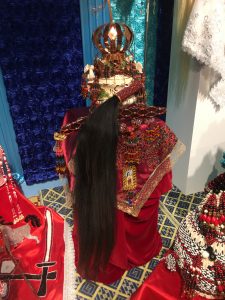Walking through “Spirited Things” exhibition in the Flemming museum, one object in particular caught my eye. It was a small cylindrical object with rings of red beads and grey putty. As I approached it, I learned it was called the “Beaded Thunderstone for God Changó Macho”. Examining it closely, I noticed how its base was a stone, and that the beads and putty were made around it. Next I looked at how the putty had gems pushed into it, and that there was figure in the center that began on a ring of putty and eclipsed through a band of red beads. This body sat with its legs crossed wearing red and gold pants. It had a small gold garment cloaked around his top, with a green gem on the chest, and a red one on the stomach. Finally, above this figure’s head was a plastic eye, and just above that was small crystal, sticking out of the top of the stone. After observing it, I thought about what its purpose was. More specifically, How is this intricate rock connected to both specific and general aspects of an entire culture? In this essay, I will examine the meaning of the Thunderstone, and how this meaning ties into the African Diaspora.

First of all, the African Diaspora is the culture from the Yoruba people in Africa that has been scattered through the americas predominantly through the slave trade. Along with being forced across the ocean, the Africans were forced to adapt their religion because slave owners wouldn’t allow them to practice it. Each different region of slaves adapted differently, creating a variety beliefs that root from the original Yoruba religion. In the Cuba, Venezuala, and all around Central America, the slaves were forced to adapt, and Santería emerged as their religion. Santería is the fusion between Christianity and the religion of the Yoruba people. The god or orişa Changó is a major god in both the Santería and Yoruba religion. He is the god of lightning and thunder and is very powerful and fierce. In Santería, he was represented as Santa Barbara because she had the same colors as Changó and was thought to be in many ways like the god himself. The Roman Catholic influence on the Yoruba religion through the means of slaves altering the Christian religion to be able to worship their own, is what lead to the popularity of Santería.
Changó Macho is one of the gods in Cuban Santería, along with Oşún, Obatalá and Yemaya. His colors are red and white, and he represents drumming, thunder and masculinity. During his life as a man, Changó was a mediocre king, but after death he achieved many great feats and became an orişa. Along with sharing the same colors, Changó and Santa Barbara share a fierce, tough and determined attitude. These aspects and colors can also be found in the thunderstone, except the symbolism is in the rocks physical properties.(Santeria Church of the Orisha, n.d.)
The first aspect of the Thunderstone that I wanted to look into, was its purpose. I wanted to know what its function was in the life of those who used it. After researching this question, I found that “Changó’s sacred thunderstones are stored in a ‘batea’ (wooden vessel) on top of a ‘pílon’ (upturned mortar)” (Ayorinde 2004, 212). In learning this, I figured out that the Thunderstones were most likely used as holy objects on altars.
In the original Yoruba religion from Africa, altars were set up by individuals to connect with the orişa that the altar is dedicated to. There is no one way to set up an altar according to the religion, but rather each altar contains objects significant to both the orişa and the individual making the altar. The altar by itself does not have any spiritual connection to the gods until it is activated in ritual. The rituals contain song and dance which empowers it with spiritual energy of Ashé, which is believed to flow through all living things in the Yoruba religion. Once the altar has been activated, the practitioner is then spiritually connected to the god and can even communicate with the orişa. During the slave trade, Santería would still have altars, but they would be disguised for Christian saints, but overtime the need to worship in secrecy has been diminished.
Since the thunderstone belonged on an altar, it must have been significant to Changó. With my previous knowledge, I knew that Changó was the god of lightning and that he was huge in war, and manly power. I was curious about why the thunderstone was significant to Changó. Going deeper in research, I found that the thunderstones were significant because it resembled Changó. The thunderstone is symbolic of Changó because its “(a) tough to crack; (b) a rigid frame not easily disintegrated by reality; (c) highly adaptable; (d) and sanctity/morality/truth, or re-affirmed action of the social order”(Lawuyi 1988, 136). Each of these reasons connect the physical aspects of the rock to the characteristics of Changó. For example, the rock itself is tough to crack, but that does not mean Changó is made of steel. Changó’s personality and honor is what does not crack.
Along with the toughness of the rock, the artistic side also has a tremendous connection with Changó. The red beads and the white gems, crystals and cowrie beads are symbolic of his favorite colors. Another aspect of the art is the black and gold figure on the front. This is a representation of the very masculine side of Changó, Changó Macho. The museum describes Changó Macho as, “to have dressed like a women in order to gain access to normal female spaces… The sculptural representations of Changó that are distinctly male are called ‘Changó Macho’”(SABA). The duality in how Changó shows how gender is both important and equal. This is because Changó, one of the most important Cuban Santería orişa, is portrayed equally important as both man and women, not more important as one gender. These aspects of the thunderstone that relate to Changó give an insight to the beliefs of the practitioners and what values of their god is important to them.
The thunderstone is a sacred object used on altar for Changó, because it resembles and is significant of Changó. This is the specific purpose of the thunderstone to the god Changó, but I am also interested in the general purpose of thunderstone as it plays a part in ritual along with the religion. In order to dissect the general purpose of the thunderstone, I examined altars as a whole. As stated previously, the objects on altars are supposed to be significant to the god the altar is devoted to, and the individual. Since practitioner is worshipping the god, what is important to the god should be what is important to the individual. In realizing this, I see now that altars are how the practitioners interpret the gods, and that the objects on the altar represent the values that the practitioner worships in the god.
As I considered this idea, I thought about other places in the religion where notions similar to this one come up. As I looked into it, I saw that the syncretization of Changó shows what values of the god was important to the slaves. Instead of representing Changó as a strong male saint, they chose Santa Barbara. The tough and fierce persona of Santa Barbara along with correlation of personal taste(color preference) show how the saint and the god both represent similar values to those that had to adapt the religion. It is also important to note that the misconceptions of men being greater than women was pretty much non-existent among the Yoruba at the time of the slave trade, because men and women both had equally important roles in the religion(Castillo and Mederos 2007, 151-157). This shows that gender was an important value to the people of both Santería and Yoruba, each gender being just as important as the other.
Through analysing both the general and specific purpose of Changó’s a better understanding of how each part of the religion connects to each other can be drawn out. The altar holds all these items which represent the god to the individual. Collectively, the altar is the is the god in the sense that it has all that values and representations of the orişa, but without life. Then it is up to the individual to bring life into the altar with song and dance, and bring life into the god that they are worshipping.
In conclusion, the purpose of the thunderstone is that it is a sacred object for an altar. By analysing this purpose, so much more information about Changó and Santería can be drawn out. The reason the thunderstone is a sacred object to Changó is because physical properties of the thunderstone represent the spiritual values of Changó. These values are then interpreted by the individual and worshipped in the form of an altar, specific to the practitioner. The accumulation of the symbolic objects along with the activation of the altar bring life to the values, turning the altar into a spiritual form of the god.
Ayorinde, Christine. 2004. “Santería in Cuba: Tradition and Transformation.” In The Yoruba Diaspora in the Atlantic World edited by Toyin Falola and Matt D. Childs, pp. 209-225. Indiana University Press, 2004.
Castillo, Daisy R., and Mederos, Aníbal A. 2007. “Lo femenino y lo masculino en la Regla Congo o Palo Monte”. In Afro-Hispanic Review, Vol. 26, No. 1, African Religions in the New World, pp. 151-157. William Luis, 2007.
Lawuyi, Olatunde B. 1988. “Ogun: Diffusion across Boundaries and Identity Constructions.”African Studies Review Vol. 31, No. 2 (Sep., 1988):pp.127-139, http://www.jstor.org/stable/524422?Search=yes&resultItemClick=true&searchText=((thunderstone)&searchText=AND&searchText=(shango))&searchUri=%2Faction%2FdoBasicSearch%3FQuery%3D%2528%2528thunderstone%2529%2BAND%2B%2528shango%2529%2529&refreqid=search%3A8cc1dc2eadc54a0d174b8cc014501bfb&seq=10#page_scan_tab_contents.
Santeria Church of Orishas. N.d. “Chango.” Accessed November 4, 2017. http://santeriachurch.org/the-orishas/chango/



